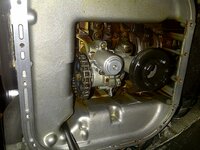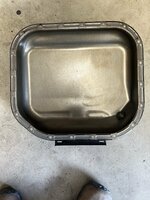First things first: thanks! All the posts and information here has gotten me a long ways to resurrecting a 1993 400E (CA model) project I inherited from my brother. When I got the car it wasn't running. With your collective help, it's on the road and getting closer to completion.
I have several (potentially related)issues:
1. Rough idle: When it starts idle is around 1000 rpm and declining to around 650 rpm. Idle speed cool is around 550 rpm, as it warms up idle speed drops to around 500 rpm and becomes somewhat erratic. It doesn't stall and runs smoothly at any speed above idle.
2. CEL will stay off after a reset and come on after several restarts. It's failed twice in Colorado for HC (3.52), CO (17.23) and NOx (3.23) with virtually the same numbers. While the test was the same, it was performed at two different stations. The high values all correlate (see figure), so I'm thinking it's either related to transient emissions associated with shifting gears, or an electrical issue. When I got the car it was definitely running rich, judging by the smell, but replacing the O2 sensor helped a lot. O2 sensor replacement also improved the idle. The car spent most of it's life in Seattle within about 300' of sea level. I sometimes wonder if it has trouble learning that there's a lot less air in Denver.
3. Charging light is dimly lit. Voltage is battery is: 12.81V. Voltage running is: 13.91V. Voltage at Fuse 5 is 12.08V. The light is off or very dim when the car starts and gets brighter the further the car is driven. Headlights don't dim (or increase the brightness of the Battery light).
Here's what been done thus far:
1. New plugs (the correct ones) gapped to 1MM
2. New caps, rotors and insulators;
3. Wires all tested at around 2.1k ohms
4. New crank position sensor with shim
5. Checked coils and they seem to be in good working order, though sometimes the spark in individual wires seems to be inconsistent.
6. Camshaft position sensor tested for continuity and appears to be working correctly
7. New flywheel (missing magnet meant no power from the right bank of cylinders)
8. New fuel pressure regulator and lines tested for correct pressure
9. New injectors
10. Water temp sensor tested for resistance and continuity
11. Air temp sensor cleaned
12. MAF was replaced by my brother and harness looks good (not ecojunk)
13. Upper wiring harness was replaced; tag confirms it's OK from a date perspective.
14. Lower wiring harness rebuilt and replaced (definitely ecojunk)
15. New alternator
16. New battery
17. New O2 sensor
18. Vacuum hoses checked with carb cleaner and smoke (no leaks)
19. All contacts in CAN cleaned with contact cleaner.
20. Diagnostic module (under floorboard) checked for connection.
21. All fuses, and fusible links replaced (Including in CAN)
22. Throttle linkage adjusted (no ASR), but I haven't adjusted the idle stop or adjusted it at the pedal.
Error codes on the blink reader are as follows:
Pin 7: Code 6 (cleared, we'll see if it stays that way)
Pin 16: Lights up when pin is inserted, but then only one blink.
Pin 30: Code 9, won't clear. But the SRS system probably isn't related to the issues at hand.
About the only things I can think of to address the idle at this point are replace the NSS, assuming Code 6 comes back on PIN 7, and completing adjustments on the throttle linkage. Any other ideas or items I may have missed would be greatly appreciated.
As far as the Battery Light issue goes, 12.08V going to the light seems low, as does the 13.91V at the battery when the care is running. My guess is that the light coming on is related more to the warning light circuit than the car not getting adequate current from the alternator. Given that the light essentially goes on due to voltage differential across the bulb, it seems like finding a source or resistance in that circuit is the best approach. The fact that voltage differential increases (and the Battery light gets brighter) as the car warms up also leads me to the conclusion that resistance in the wiring is the culprit. Any ideas on where to start looking would be great.
Thanks again for all of the collective wisdom.
I have several (potentially related)issues:
1. Rough idle: When it starts idle is around 1000 rpm and declining to around 650 rpm. Idle speed cool is around 550 rpm, as it warms up idle speed drops to around 500 rpm and becomes somewhat erratic. It doesn't stall and runs smoothly at any speed above idle.
2. CEL will stay off after a reset and come on after several restarts. It's failed twice in Colorado for HC (3.52), CO (17.23) and NOx (3.23) with virtually the same numbers. While the test was the same, it was performed at two different stations. The high values all correlate (see figure), so I'm thinking it's either related to transient emissions associated with shifting gears, or an electrical issue. When I got the car it was definitely running rich, judging by the smell, but replacing the O2 sensor helped a lot. O2 sensor replacement also improved the idle. The car spent most of it's life in Seattle within about 300' of sea level. I sometimes wonder if it has trouble learning that there's a lot less air in Denver.
3. Charging light is dimly lit. Voltage is battery is: 12.81V. Voltage running is: 13.91V. Voltage at Fuse 5 is 12.08V. The light is off or very dim when the car starts and gets brighter the further the car is driven. Headlights don't dim (or increase the brightness of the Battery light).
Here's what been done thus far:
1. New plugs (the correct ones) gapped to 1MM
2. New caps, rotors and insulators;
3. Wires all tested at around 2.1k ohms
4. New crank position sensor with shim
5. Checked coils and they seem to be in good working order, though sometimes the spark in individual wires seems to be inconsistent.
6. Camshaft position sensor tested for continuity and appears to be working correctly
7. New flywheel (missing magnet meant no power from the right bank of cylinders)
8. New fuel pressure regulator and lines tested for correct pressure
9. New injectors
10. Water temp sensor tested for resistance and continuity
11. Air temp sensor cleaned
12. MAF was replaced by my brother and harness looks good (not ecojunk)
13. Upper wiring harness was replaced; tag confirms it's OK from a date perspective.
14. Lower wiring harness rebuilt and replaced (definitely ecojunk)
15. New alternator
16. New battery
17. New O2 sensor
18. Vacuum hoses checked with carb cleaner and smoke (no leaks)
19. All contacts in CAN cleaned with contact cleaner.
20. Diagnostic module (under floorboard) checked for connection.
21. All fuses, and fusible links replaced (Including in CAN)
22. Throttle linkage adjusted (no ASR), but I haven't adjusted the idle stop or adjusted it at the pedal.
Error codes on the blink reader are as follows:
Pin 7: Code 6 (cleared, we'll see if it stays that way)
Pin 16: Lights up when pin is inserted, but then only one blink.
Pin 30: Code 9, won't clear. But the SRS system probably isn't related to the issues at hand.
About the only things I can think of to address the idle at this point are replace the NSS, assuming Code 6 comes back on PIN 7, and completing adjustments on the throttle linkage. Any other ideas or items I may have missed would be greatly appreciated.
As far as the Battery Light issue goes, 12.08V going to the light seems low, as does the 13.91V at the battery when the care is running. My guess is that the light coming on is related more to the warning light circuit than the car not getting adequate current from the alternator. Given that the light essentially goes on due to voltage differential across the bulb, it seems like finding a source or resistance in that circuit is the best approach. The fact that voltage differential increases (and the Battery light gets brighter) as the car warms up also leads me to the conclusion that resistance in the wiring is the culprit. Any ideas on where to start looking would be great.
Thanks again for all of the collective wisdom.






















